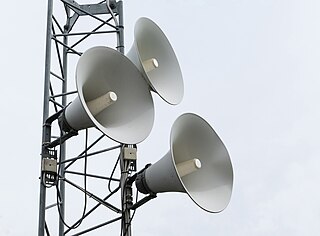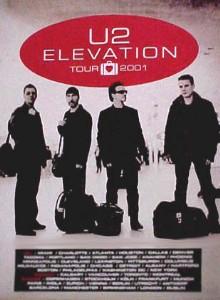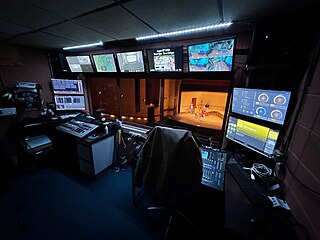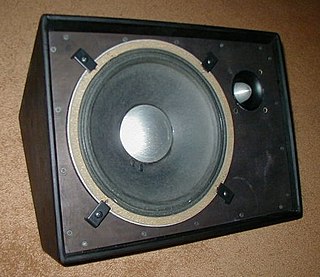
A mixing console or mixing desk is an electronic device for mixing audio signals, used in sound recording and reproduction and sound reinforcement systems. Inputs to the console include microphones, signals from electric or electronic instruments, or recorded sounds. Mixers may control analog or digital signals. The modified signals are summed to produce the combined output signals, which can then be broadcast, amplified through a sound reinforcement system or recorded.

A stage box is an interface device used in sound reinforcement and recording studios to connect equipment to a mixing console. It provides a central location to connect microphones, instruments, and speakers to a multicore cable (snake), which allows the sound desk to be further from the stage and simplifies setup.

A public address system is an electronic system comprising microphones, amplifiers, loudspeakers, and related equipment. It increases the apparent volume (loudness) of a human voice, musical instrument, or other acoustic sound source or recorded sound or music. PA systems are used in any public venue that requires that an announcer, performer, etc. be sufficiently audible at a distance or over a large area. Typical applications include sports stadiums, public transportation vehicles and facilities, and live or recorded music venues and events. A PA system may include multiple microphones or other sound sources, a mixing console to combine and modify multiple sources, and multiple amplifiers and loudspeakers for louder volume or wider distribution.

A sound reinforcement system is the combination of microphones, signal processors, amplifiers, and loudspeakers in enclosures all controlled by a mixing console that makes live or pre-recorded sounds louder and may also distribute those sounds to a larger or more distant audience. In many situations, a sound reinforcement system is also used to enhance or alter the sound of the sources on the stage, typically by using electronic effects, such as reverb, as opposed to simply amplifying the sources unaltered.

The Elevation Tour was a worldwide concert tour by Irish rock band U2. Staged in support of the group's 2000 album All That You Can't Leave Behind, the tour visited arenas across North America and Europe in 2001. Contrasting with the extravagant, outdoor productions of the band's previous two live ventures, the Zoo TV Tour (1992–1993) and the PopMart Tour (1997–1998), the Elevation Tour saw them return to indoor arenas with a much more stripped-down, intimate stage design. The stage featured a heart-shaped catwalk that encircled many audience members, and festival seating was offered in the United States for the first time in the group's history.

In professional audio, a digital mixing console (DMC) is a type of mixing console used to combine, route, and change the dynamics, equalization and other properties of multiple audio input signals, using digital signal processing rather than analog circuitry. The digital audio samples, which is the internal representation of the analog inputs, are summed to what is known as a master channel to produce a combined output. A professional digital mixing console is a dedicated desk or control surface produced exclusively for the task and is typically more robust in terms of user control, processing power and quality of audio effects. However, a computer can also perform the same function since it can mimic its interface, input and output.
A theatrical technician, also known as a theatrical tech, theatre technician, or theatre tech is a person who operates technical equipment and systems in the performing arts and entertainment industry. In contrast to performers, this broad category contains all "unseen" theatrical personnel who practice stagecraft and are responsible for the logistic and production-related aspects of a performance including designers, operators, and supervisors.
In theater, dance, and live musical performances, a rider is a set of requests or demands that a performer sets as criteria for performance, which are typically fulfilled by the hosting venue. Types of riders include hospitality and technical.

The control booth, control room, lighting box, technical booth, tech booth, or just booth used by television, film or theatrical technicians is the area designated for the operation of technical equipment, lighting controls and sound board. Often one or two followspots may be located in the booth as well. In a theater, it is generally an enclosed space with a large sliding window with a good view of the stage centered in the back of the house. It may be on the ground floor or at the balcony level. In a film or television production, it might be in a trailer or other space near the studio.

Live sound mixing is the blending of multiple sound sources by an audio engineer using a mixing console or software. Sounds that are mixed include those from instruments and voices which are picked up by microphones and pre-recorded material, such as songs on CD or a digital audio player. Individual sources are typically equalised to adjust the bass and treble response and routed to effect processors to ultimately be amplified and reproduced via a loudspeaker system. The live sound engineer listens and balances the various audio sources in a way that best suits the needs of the event.

A soundcheck is the preparation that takes place before a concert, speech, or similar performance to adjust the sound on the venue's sound reinforcement or public address system. The performer and the audio engineers run through a small portion of the upcoming show to ensure the venue's front of house and stage monitor systems are producing clear sound, are set at the proper volume, and have the correct mix and equalization. When applied to microphones exclusively, it is more commonly called a mic check.
There are different types of theatres, but they all have three major parts in common. Theatres are divided into two main sections, the house and the stage; there is also a backstage area in many theatres. The house is the seating area for guests watching a performance and the stage is where the actual performance is given. The backstage area is usually restricted to people who are producing or in the performance.

The term backline is used in popular music and sound reinforcement system contexts to refer to electronic audio amplification equipment and speaker enclosures that are placed behind the band or the rhythm section on stage, including amplifiers and speaker cabinets for guitars, bass guitars and keyboards. Such equipment is often rented or leased by the band or their management, or provided by the venue. Speakers placed at the front of the stage facing the performers are also known as monitor speakers or "foldback". The main speakers facing the audience are sometimes referred to as "front of house speakers".
Audio signal flow is the path an audio signal takes from source to output. The concept of audio signal flow is closely related to the concept of audio gain staging; each component in the signal flow can be thought of as a gain stage.

A stage monitor system is a set of performer-facing loudspeakers called monitor speakers, stage monitors, floor monitors, wedges, or foldbacks on stage during live music performances in which a sound reinforcement system is used to amplify a performance for the audience. The monitor system allows musicians to hear themselves and fellow band members clearly.

An audio engineer helps to produce a recording or a live performance, balancing and adjusting sound sources using equalization, dynamics processing and audio effects, mixing, reproduction, and reinforcement of sound. Audio engineers work on the "technical aspect of recording—the placing of microphones, pre-amp knobs, the setting of levels. The physical recording of any project is done by an engineer…"

Bruce Robert Jackson was an Australian audio engineer who co-founded JANDS, an Australian audio, lighting and staging company. He joined American touring audio engineer Roy Clair and mixed concert stage monitors for Elvis Presley in the 1970s. With Clair Brothers, a concert sound company, Jackson designed audio electronics including a custom mixing console. Beginning in 1978, Jackson toured as Bruce Springsteen's band engineer for a decade, using Clair Brothers sound systems. A business interest in Fairlight CMI in Sydney introduced Jackson to digital audio, and he subsequently founded the digital audio company Apogee Electronics in Santa Monica, California, where he lived at the time. After selling his share of Apogee, Jackson co-founded with Roy and Gene Clair a joint venture which produced the Clair iO, a loudspeaker management system for control of complex concert sound systems. Jackson turned the venture commercial with the help of Dave McGrath's Lake Technology. Dolby Laboratories bought the technology and formed Dolby Lake with Jackson as vice president, then in 2009 Lab.gruppen acquired the brand. Jackson was honoured with the Parnelli Innovator Award in 2005 for his inventive loudspeaker controller.

McCune Audio Video Lighting is an American company based in South San Francisco, California, with offices in Monterey and Anaheim. It is one of the oldest and largest audio visual rental and sound services in the U.S. McCune was founded in 1932 by Harry McCune Sr, McCune AVL provides audio, lighting and high-definition video services to events as varied as outdoor festivals such as the Monterey Jazz Festival, and the Bohemian Grove, and to arena conferences such as TED.
Clair Global, or simply Clair, is a professional sound reinforcement and live touring production support company. It was founded by brothers Roy and Gene Clair, who went into business in 1966 after they were asked to bring their sound system on tour with Frankie Valli and the Four Seasons. It is believed they were the first professional sound company to tour with a band. The company formally incorporated in 1970 as Clair Bros. Audio Enterprises, Inc.
Antony King is a British live audio engineer for Foo Fighters, Depeche Mode and Nine Inch Nails. He has also worked as front of house engineer for The Cure, Noel Gallagher's High Flying Birds, Prince, The Weeknd, Lana Del Rey, Kanye West, Calvin Harris, Swedish House Mafia, ,Zayn, Beck, Marilyn Manson, The Faces, and Simply Red.














